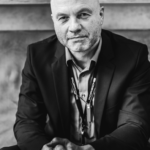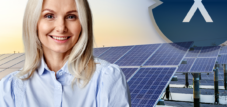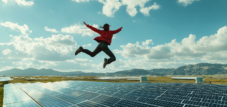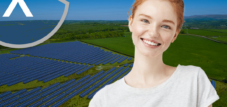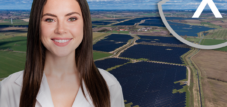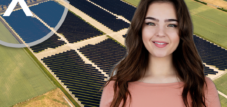Published on: March 29, 2025 / update from: March 29, 2025 - Author: Konrad Wolfenstein

Solarpark Transformation of former lignite areas in Saxony: Pödelwitz and Witznitz - Germany's largest solar park - Image: Xpert.digital
From the open -cast mine to solar transformation: the change in Saxony
Photovoltaics instead of coal: A look at the Saxon energy landscape
The Witznitz energy park and the solar systems in Pödelwitz represent a significant change in the Saxon energy landscape. Former diary areas are increasingly being created on photovoltaic systems that enable sustainable energy supply and at the same time contribute to the economic restructuring of the region. The Witznitz energy park has established itself as the largest solar park in Germany, while MIBRAG has made an important contribution to self -power supply and regional energy transition with its projects at Pödelwitz.
Suitable for:
- This is how much space the sun needs: How much space does a solar park need at least to be able to be operated economically?
Energiepark Witznitz: Germany's largest solar park
The Witznitz energy park was officially put into operation in July 2024 and marks a milestone in the German energy transition. With an installed output of 605 megawatts and a planned expansion to 650 megawatts, it is the largest solar park in Germany. The impressive complex extends over an area of around 500 hectares, which corresponds to around 700 soccer fields and was built on the site of a former lignite mining.
The construction of the energy park began on June 8, 2022, and around 1.1 million solar modules were installed within two years. The facility went into operation in April 2024 and was officially opened in July 2024. At the opening ceremony, Saxony's Prime Minister Michael Kretschmer emphasized the importance of the project: “This largest solar park in Germany is in the middle of the Central German area. We see that the renewables have a chance and look forward to this large investment point here in Central Germany."
Financing and profitability
A remarkable aspect of the Witznitz energy park is his innovative financing model. The entire facility was fully implemented without government funding, financed by the largest sustainability investment of the Signal Iduna Group and its financial daughter Hansainvest Real Assets. Martin Berger, CFO of the Signal Iduna Group, emphasized the importance of investing as a lighthouse project of the energy transition. This decision underlines the responsibility of the insurance group for a sustainable future and at the same time set an important impulse for the economic revival of the region.
Instead of relying on government funding, the energy produced is sold directly to Shell over a period of 15 years, which in turn forwards the electricity to Microsoft data centers. This direct acceptance agreement ensures the economy of the project in the long term.
Power supply and ecological aspects
With its enormous performance, the Witznitz Energy Park can calculate the average annual needs of around 200,000 four-person households. As a result, emissions of more than 250,000 tons of CO₂ can be saved. In addition to the installed solar surface, 1.2 square kilometers of ecological compensation area were also created.
The electricity feeding takes place directly into the maximum voltage network, which was already available in the region due to the earlier lignite mining. However, after commissioning, there were also complaints about a hum that comes from the substation. Around 70 such complaints were received in the Borna district office, and although no guidelines were exceeded, further measurements are to be carried out and noise protection measures are taken.
MIBRAG solar parks: Energy transition in the open-cast mine united Schleenhain
In parallel to the major project in Witznitz, the Central German lignite company (MIBRAG) has implemented its own solar park projects on former site space. The Solarpark Peres II near Pödelwitz was officially put into operation in September 2023 and is an important step in the company's transformation.
Technical data and investment
The MIBRAG invested around 25 million euros in the Solarpark Peres II. 66,000 solar modules were installed on an area of a total of 55 hectares, which can generate 37 megawatt peak at peak times. The energy generated corresponds to the consumption of around 15,000 households.
Armin Eichholz, chairman of the MIBRAG management, emphasized when commissioning: "At peak times we can create 37 megawatt peak and use the green electricity to operate our opencast mine." The solar park was created on a recultivated area of the Schleenhain open -cast mine and primarily serves to supply the mining company's own current.
Expansion of solar capacities
In December 2024, MiBrag put its third photovoltaic system into operation with Peres West I. This system with an output of 43 megawatt peak was also built on a recultivated area of the open -cast mining Schleenhain and represented an investment volume of 24 million euros. With this extension, MIBRRAG has more than doubled its solar capacities and is now achieving an overall output of around 80 megawatt peak.
Dr. Armin Eichholz explained: "In this way we immediately strengthen our own current supply and create a powerful basis in order to be able to produce green hydrogen as an energy and industrial service provider at the Proven location." The annual electricity production of Peres West I is estimated at around 41,000 megawatt hours, which is sufficient to supply around 16,000 households with renewable energy.
Ecological measures
Extensive ecological compensation measures were also carried out in the implementation of the Peres II solar park. Large maps of flora and fauna in 2021 were part of the technical project planning. On this basis, 45 partially connected individual habitats were created to protect fence lizards and insects, and hedges were planted as a compensation area for breeding birds.
Suitable for:
Transformation of the Central German territory
The solar parks in Witznitz and Pödelwitz are part of a larger transformation of the Central German territory. Dominique Guillou, Managing Director of the Epne (EP New Energy), which also includes MIBRAG, describes the commissioning of the Solar Park Peres II as a “another important step towards transformation of the central German area to a modern energy and industrial location based on renewable energies and hydrogen production”.
The conversion of former diary areas for solar energy generation is a sensible reuse that offers both ecological and economic advantages. In the future, the Witznitz energy park will provide a third of the performance of the nearby coal-fired power plant and thus make an important contribution to the structural change in the former lignite region.
Transformation in the area: Pödelwitz is fighting for his future
Despite the positive developments, there are also challenges in the transformation of the area. In Pödelwitz, where a solar field was also created, old and new villagers fight with the situation that MiBrag, as the owner of many houses, is increasingly leaving it. The “Pödelwitz has a future” association was recently able to acquire a house from the group, but the revival of the place is difficult.
Lausitz plans: up to 14 gigawatts for renewable energies
The solar parks in Witznitz and at Pödelwitz mark significant progress for the energy transition in Saxony. A spokesman for the Saxon Ministry of Energy emphasized the size of the Witznitz energy park and explained that this made a significant contribution to Saxony's energy balance. To clarify, he stated that the entire expansion of photovoltaics in Saxony was around 650 MWP in 2023.
The epne, to which MIBRAG belongs, has identified a potential of 1 gigawatt for renewable energies alone with MIBRAG, of which 250 megawatts are already under development. The plans for Lusatia are even greater, where there is talk of 7 to 14 gigawatts.
How former lignite areas in Germany contribute to the energy transition
The solar parks in Witznitz and at Pödelwitz show an example of how former lignite areas can be used for renewable energy generation. The Witznitz energy park as the largest solar park in Germany and the MIBRAG projects at Pödelwitz contribute significantly to the redesign of the energy landscape in Saxony and support the structural change in the affected regions. These projects not only promote sustainable energy supply, but also support the economic development in the areas affected by the coal phase -out.
This transformation is an important contribution to the energy transition in Germany and shows how former industrial areas can be used for the production of renewable energies. The combination of ecological compensation measures and renewable energy generation also creates added value for the environment and climate.
Suitable for:
Your partner for business development in the field of photovoltaics and construction
From industrial roof PV to solar parks to larger solar parking spaces
☑️ Our business language is English or German
☑️ NEW: Correspondence in your national language!
I would be happy to serve you and my team as a personal advisor.
You can contact me by filling out the contact form or simply call me on +49 89 89 674 804 (Munich) . My email address is: wolfenstein ∂ xpert.digital
I'm looking forward to our joint project.




